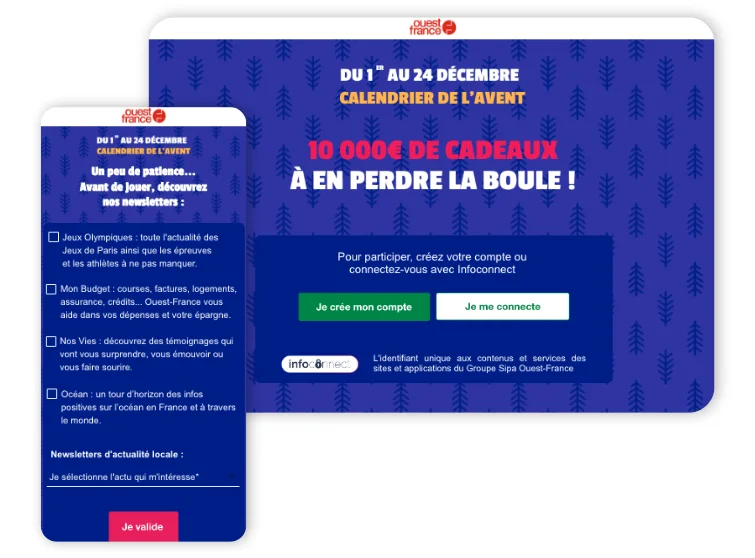
Ouest France: how to attract new users through gamification
Developing a mailing list and collecting new users are key issues. Once subscriptions have been made and opt-in obtained, this audience can receive information about services or products.
There are several ways of encouraging prospects to register for a tool, service or platform. The collection of opt-ins and registration can be offered at different points in the marketing journey. By optimising this strategy, brands can expand their audience and hope to convert and retain a large number of customers.
Marketing highlights, when consumers are interested in brand content, are crucial moments. By creating effective campaigns, using techniques such as gamification, brands can collect enriched and reactivatable opt-ins.
In this article, we explore how to turn a branded event into an opportunity to generate users. We will look at the notion of enriched opt-ins and how they can encourage the act of buying. To illustrate this, we’ll take the example of a campaign run by the Ouest France media.
Marketing challenges in the press sector
In the age of the Internet and social networks, the press media are faced with marketing and commercial challenges. It is becoming complicated for companies to maintain their financial health, given the competitors that have emerged. These include pure-play media (such as Mediapart), which have taken on the print media, as well as influencers and content creators. The latter represent an alternative to traditional media (among the younger generation).
Among the challenges facing the sector, the media point to the decline in advertising and their traditional sources of revenue. They have had to turn to new business models (the paywall, which consists of offering certain content free of charge to encourage visitors to take out a paying subscription).
Trust in information is a priority for the media. They cite the accuracy of the content (40%), being perceived as a trusted medium (23%), as well as audience development (17%) as the main issues they need to work on. The veracity of information and the reliability of sources are at the heart of their concerns, particularly in the face of the arrival of AI.
Attract new users to meet media challenges
To meet these challenges (standing out from the competition, converting readers, creating a bond of trust), the media are turning to the collection of new users and enriched optins (collecting preference data in addition to user consent).
By developing their mailing lists and subscriber bases, companies can build up an audience with which to communicate directly (via personalised emails).This audience can be nurtured (this is known as lead nurturing) to provide them with high value-added content. This may involve encouraging them to create an account or take out a paid subscription in exchange for benefits (exclusive offers).
This registration will create a link between the prospect and the media. It will enable the company to to achieve several objectives that are crucial to its growth:
- Better understand your audience and collect their preferences (content categories and formats, preferred information channels). This data will enable the media to adapt its editorial line and offer personalised newsletters;
- Reactivate users interested in the media by offering them incentives to create an account or even take out a paying subscription (discounts, goodies, etc.);
- Generate visits by offering relevant content that encourages subscribers to visit the site. This increase in traffic will enable the company to negotiate advertising partnerships and generate greater revenue.
Gamify a special event to collect enriched opt-ins
Gamification is an effective way of collecting registrations and enriched optins. The interactive and playful nature of the game mechanics helps to attract and capture the attention of its target audience.
By offering a reward in return (discount, voucher, exclusive content), the media can easily encourage their audience to share their email and consent to the communication being sent.
This strategy is effective when it is implemented during a peak marketing period. Users are alert to the opportunities that brands can offer and are more inclined to make a purchase. The end-of-year festivities are a high-consumption period. A media audience will be looking for good deals to save on a subscription, for themselves or as a gift.
With an opt-in valid for 13 months, the media will be able to use gamification to re-engage their database (and collect new data).
The example of Ouest France
The Ouest France media chose to use gamification marketing to animate its audiences during the month of December. The aim of the campaign was to develop this audience.
Participants in the operation had to create a Ouest France account to take part in the Advent Calendar. To reach a wide audience, the competition was broadcast on the newspaper’s website, on its app, in the press and via email campaigns.
Every day, from 1 to 24 December, Ouest France offered an animation in the form of boxes to be opened. After creating an account and filling in the collection form, participants could win attractive prizes such as a holiday, household and high-tech appliances, shopping vouchers, etc.

The objective was more than achieved, since 25% of the participants in the operation came from the creation of a new account (i.e. 21,000 new accounts created via the operation).
Ouest France was able to capitalise on the engagement to collect enriched opt-ins on different themes (thematic preferences of future readers). The medium was then able to use this data to encourage subscriptions via targeted retargeting email campaigns.

Conclusion
Gamification, particularly during a peak period in the marketing calendar, is an excellent strategy for attracting new subscribers and enriching your customer base. Discover
our marketing animation catalog and boost customer account creation!




